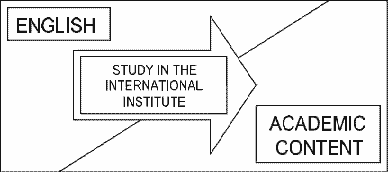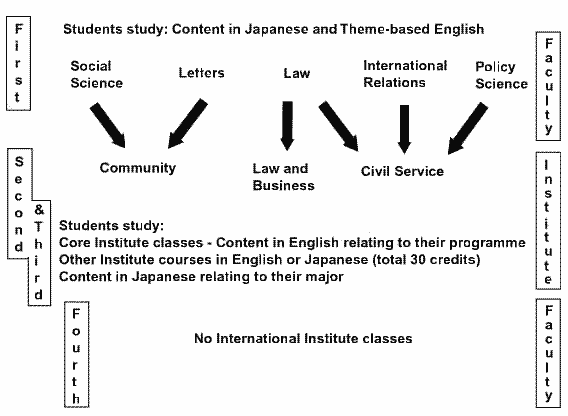
Figure 1: Transition from focus on language to focus on content.
Themes to content:
by Anna Seabourne (Ritsumeikan University)
|
| "This paper . . . introduce[s] the new cross-faculty International Institute program at Ritsumeikan University and explain[s] how it fits into the curriculum as a whole." |
| Theme-based: | Teaching with a primary goal of developing language skills; content is secondary. |
| Content-based: | The primary goal of the lesson is communicating the content. Language work is included to provide a supportive learning environment. |
[ p. 13 ]


[ p. 14 ]
Structure| Faculty of Law | 1st semester required for all first year students |
| English I | Strategies for Active Communication (1st stage) Twice a week with the same teacher (Japanese). Integrated skills, focus on reading and writing. |
| English II | Workshop (1st stage) Twice a week with the same teacher (native speaker of English). Integrated skills, focus on speaking and listening, content-based. Culture. |
[ p. 15 ]
| Program | Social Science | Letters | Law | International Relations | Policy Science | Total |
| International Civil Service | 35 | 35 | 35 | 105 | ||
| International Community | 35 | 35 | 70 | |||
| International Law and Business | 35 | 35 |
[ p. 16 ]
| Economics through English; Politics through English; Law through English (once a week/2 credits/1 semester; approximately 25 students per class) The objective for these once-a-week content-based courses is to enable the students to become familiarised with the specialised vocabulary related to the respective fields, so much so that the students are able not only to read about these areas without checking the dictionary but also to be able to use it in their presentations and writing. There will be a list of recommended textbooks unless the instructor has other recommendations, which recommendations also require prior formal approval. (Wakana, 2001, p. 10) |
[ p. 17 ]
Goals
What is politics? What does it mean to be a citizen of a state? What does it mean to be patriotic? What is the role of the individual in politics? How did the state evolve? What is society made of? How is power balanced between states? How can you get involved in politics? What are justice, freedom and democracy? Why do we have political parties? Can we study politics objectively? What is the future of politics? These are just some of the questions which will be read about and discussed in class. |
[ p. 18 ]
Resources| "At the moment, the success or otherwise of the program is relying mainly on anecdotal evidence." |
[ p. 19 ]
Notes1. The following is an unedited sample from a second year student's journal entry -Acknowledgements
Some people say that because of social and cultural internationalisation, our identity (as Japanese) is gradually weakening. But my opinion is that it is not necessarily true. If there are not transnational relationships between cultures, societies or economies, we wouldn't have as much sense of identifications of our selves as now. Moreover, "identity" is something that forms and develops itself by accepting different things from outside. I think that we have pursue more peaceful, effective and productive way of internationalization, and it's also for the sake of identity of each of us (on the earth).
2. Some recent examples of questions include, "What is the difference between a nation and a state?", "Why is Britain not part of the Euro area?", "Does providing a haircut come under the laws affecting sale of goods or sale of services?"
3. Titles of the third year papers include From nuclear deterrence to nuclear abolition: The historical backdrop on (sic) nuclear proliferation and the movements for nuclear abolition; Environmental issues and globalisation: Comparing global and local issues; Globalisation and regional integration: The foresight of the WTO and the EU; Globalisation and poverty: Free trade to fair trade.